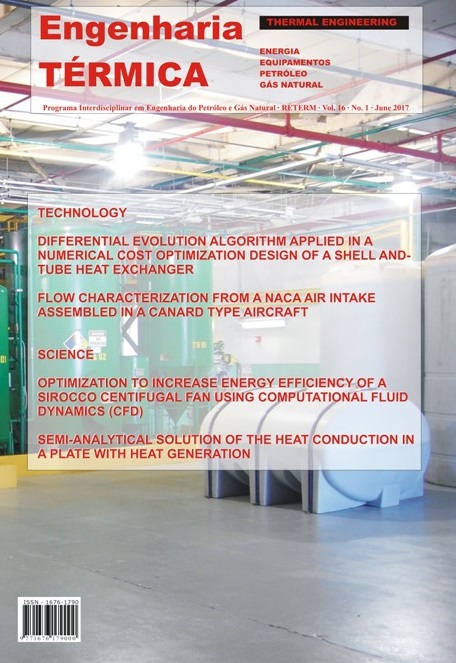NUMERICAL STUDY OF A TRIANGULAR FIN INSERTED IN A SQUARE CAVITY WITH UPPER SLIDING SURFACE SUBJECTED TO A MIXED CONVECTION EFFECT
DOI:
https://doi.org/10.5380/reterm.v16i1.62196Keywords:
constructal design, mixed convection, Nusselt number, square cavity, triangular finAbstract
This article investigates numerically, using the Constructal Design method, a system that combines a square cavity with upper sliding wall and a triangular fin subjected to the mixed convection effect. The objectives are to evaluate the influence of the fin aspect ratio (H1/L1) on the average Nusselt number on the fin surface and to analyze the effect of the fraction of the area of the triangular fin relative to the square cavity (φ). The proposed problem is assumed two-dimensional, laminar, incompressible and steady flows. For the buoyancy forces it is considered the Boussinesq approximation. In order to generalize the results, the problem is solved in dimensionless form. The fluid flowing through the cavity presents the thermophysical properties defined by the Prandtl number (Pr = 0.71). The buoyancy force in the flow is defined by the Rayleigh number (RaH = 104), while the flow regime is governed by the Reynolds number (ReH = 102). The optimum fin geometry that maximizes the heat transfer between the finned cavity and the surrounding fluid is obtained through the Constructal Design method. The numerical solution of the conservation equations of mass, momentum and energy is calculated with the finite volume method, using the commercial fluid dynamics software FLUENT®. The geometry and mesh computational domain were developed in GAMBIT® package. As results, it was found that the optimal configurations of H1/L1 presented a gain in the thermal performance of up to 15% in relation to the other geometries. In addition, the heat transfer has great dependence on the variation of the fraction of area (φ).
Downloads
Published
How to Cite
Issue
Section
License
Direitos Autorais para artigos publicados nesta revista são do autor, com direitos de primeira publicação para a revista. Em virtude da aparecerem nesta revista de acesso público, os artigos são de uso gratuito, com atribuições próprias, em aplicações educacionais e não-comerciais.



